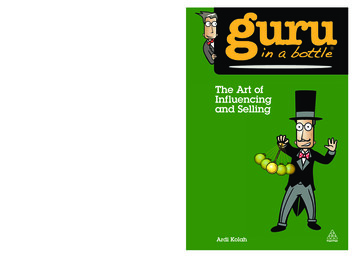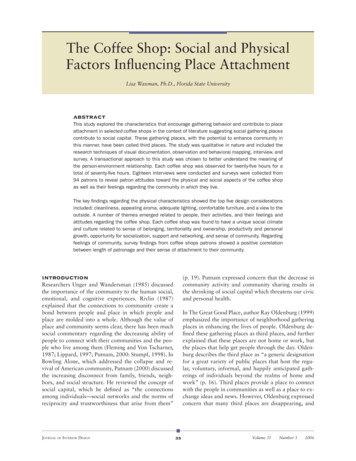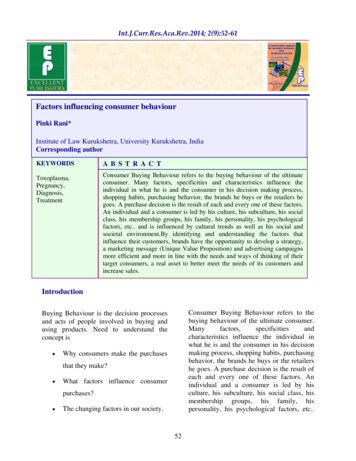
Transcription
Let me show you how to getgreat sales results - fast!This book will help you to usetried and tested no-fuss salestechniques to approachprospective customers andclients without them wantingto run a mile! We’ll give you theconfidence to write and delivereffective sales material andpresentations as well aspositively negotiate and closethe sale.You’ll learn how to makeintelligent use of databases andother sales tools rather thanbecoming a slave to them, andhow to create a realistic salespipeline. You’ll develop skillsthat will get the most out of yourinvestment in sales andmarketing activities. Jargon free Accessible No detailedknowledgerequired Signpoststhe readerto all theimportant bits The GURU isout of theBOTTLE!Kogan PageLondonPhiladelphiaNew Delhiwww.koganpage.com 19.99US 29.95The Art ofInfluencingand SellingArdi KolahArdi Kolah LL.M is a prolific author andone of the most respected marketing andcommunication practitioners in the world. Heholds a Master’s degree in law and is a fellow ofthe Chartered Institutes of Marketing and PublicRelations, and a Liveryman of the WorshipfulCompany of Marketors. His unique approachhas made Guru in a Bottle extremely popularI S B NStates978-0-7494-6448-6throughout Europe, the Unitedand India.The Art of Influencing and SellingThe Art ofInfluencingand SellingISBN: 978-0-7494-6448-69 780749 464486Sales and marketingKoganPageArdi Kolah
ContentsAbout the author ixIntroduction1About this book 21 Psychology of selling a product orservice or yourself 5The art of persuasion 5The big issue 6Trust builder 7Redefinition of selling 9Seeing things differently 10Collaboration is the future of selling 11Hypnotizing the audience to fall under your spell! 132 The sales pipeline and how toensure it’s realistic 17Introduction 17Doing business on customers’ terms 19The lead conversion process 28Real and virtual worlds of prospecting for customers or clients 42Monitoring the performance of your prospecting efforts 493 Up-selling, cross-selling,cold calling and warm callingIntroduction 63The myths about selling 64Asking the right questions 6563
viContentsHow to build rapport 66How to apply outcome thinking 68The art of up-selling 69How to cross-sell successfully 77How to cold-call without someone hanging up 79How to turn a warm call into a sale 854 Effective approaches to prospectivecustomers and clients 89Introduction 89Six ways to make a lasting impression 90Understanding the short cuts to getting what we want 95The art of sales negotiation 96The future is about collaborating for profit 995 How to interrogate a database ofcontacts to get more sales 103Introduction 103Developing a customer, client and supporter database 105Basic principles of data mining 106Customer, client and supporter acquisition strategies 109Using survival analysis to understand customers, clients andsupporters 1186 Making an effective salespresentation 123Introduction 123It’s about them, not about you 126Overcoming your fears 130Prior preparation prevents poor performance 137Body talk 141Delivering an effective sales pitch 146How to avoid ‘death by bullet points’ 157How to make a great close 1607 How to write effective salesmaterials 167Introduction 167Outside in, not inside out 169Content is king 170
ContentsSales copy tips 174E-mail 178Web page 182Online newsletters 187Google AdWords 189Sales letter 196Product sales brochure 198International Chamber of Commerce Code (2011) 1998 The power of businessnetworking 207Introduction 207Face to face 209Word of mouth 214Power of social media 218Brand advocacy 219Customer and client feedback 221LinkedIn 225Twitter 230Facebook 2339 How to get senior-levelappointments in your diary239Introduction 239Doing your homework 240The basic etiquette of making an appointment 241Identifying the appropriate decision maker 246Getting past the gatekeeper 249Tools to get appointments – LinkedIn 25010 Closing a sale and follow-up255Introduction 255You’ve one chance to make a good first impression 257Asking for what you want 258Reading the signs 259Overcoming objections and concerns 261Remote closing 265Maintaining the customer or client through to the next sale 275Index 281Endorsements 289vii
IntroductionThe art of influencing and selling is neatly summarized by this quotetaken from the book How to Win Friends and Influence People byUS sales guru Dale Carnegie: ‘When dealing with people, let usremember we are not dealing with creatures of logic. We are dealingwith creatures of emotion, creatures bristling with prejudices and motivatedby pride and vanity.’ What’s fascinating is that this was written in 1953 andwell before access to the powerful databases we have today, which containmillions of bits of data on just about every aspect of our lives that it islegally possible to hold.What Dale Carnegie said then holds true today. If we only operate ona rational basis in order to try to influence our desired customer or clientto purchase our product or service, then we’ll fail miserably.It’s true that we mustn’t ignore logic or the ability of critical argumentand evaluation that dominates so much of the way in which we are taughtto think and make decisions. Just look at the soap powder TV commercialsof the 1950s and 1960s, where consumers were blinded with the power ofthe technology to make their clothes ‘whiter than white’! There was almosta messianic obsession about selling features rather than benefits. And if youthink times have changed and that approach is dead and buried along withthe cheesy commercials with women restricted to the role of housewives,well I’m afraid it’s still alive and kicking amongst some businesses! Theproblem is that the traditional thinking we apply to today’s sales challengesjust isn’t up to the job any more.What many of the most successful businesses on the planet have incommon is the ability to challenge the conventional wisdom that has fortoo long dominated the way we think. In essence, these organizations havereplaced one-dimensional with multidimensional thinking.Much of our thinking is done in a disorganized, inefficient way. We oftentry to do too much at once. Emotions, information, logic, hope, risk andcreativity are all mixed up together. It’s like juggling too many balls all atonce, and some end up getting dropped. As a result of this juggling act, webegin to limit our thinking and make poor decisions. Often, we tend to useonly one type of thinking at any given moment. Yet one type of thinking isno longer adequate to cope with today’s rapidly changing and challenging
2The Art of Influencing and Sellingcommercial environment. Judgement and argument can no longer solve allproblems or move us forward. We need a multidimensional approach inorder to succeed.And this is what this book is about. We need to think about influencingand selling in 3D and not just online! We need to be collaborative, focused anddirected. We need, in short, to rewire our thinking about how to influenceand sell to our desired customer and client segments wherever we are andwhatever business we happen to be in. We need to be able to navigate differentavenues of thought to build insight, creative ideas and effective sales solutions if we want to be successful in this endeavour.If you follow the approach we advocate here in this book, then you’ll beon your way to creating more sales for your business. And the guru won’tjust be out of the bottle. The guru will be you!About this bookChapter 1: Psychology of selling a product or service or yourselfIn this chapter, we’ll look at the psychology of influence and the role thatyou play regardless of the product or service you’re trying to sell.Chapter 2: The sales pipeline and how to ensure it’s realisticIn this chapter, we’ll show you how to put together a realistic rather thanpie-in-the-sky sales pipeline where the chances of success are greater andwill keep a smile on the face of your boss!Chapter 3: Up-selling, cross-selling, cold calling and warm callingIn this chapter, we’ll analyse and rehearse the key skills you need to beeffective in getting a chance of making a sale with a desired customer orclient prospect.Chapter 4: Effective approaches to prospective customers and clientsIn this chapter, having discussed how the tools work and what you need tomake a sale, we’ll show you how to strut your stuff.Chapter 5: How to interrogate a database of contacts to get more salesIn this chapter, we’ll take a no-fuss look at database marketing withoutmaking you glaze over in the process!Chapter 6: Making an effective sales presentationIn this chapter, we’ll take you through some of the best ways in which tomake a first impression in a sales presentation by looking at some ofthe tips and tricks used by seasoned sales presenters.
IntroductionChapter 7: How to write effective sales materialsIn this chapter, we’ll show you the way you should approach having towrite sales brochures, newsletters and flyers that are aimed at customersand clients and reduce the chance of them being deleted or ending up inthe waste bin!Chapter 8: The power of business networkingIn this chapter, we’ll show you how to use the power of online and offlinenetworking, as well as the importance of being recommended by othercustomers and clients, which could be your most powerful sales weapon.Chapter 9: How to get senior-level appointments in your diaryIn this chapter, we’ll show you how to get past the ‘gatekeeper’ and getthat all-important appointment with the key decision maker who canauthorize to spend budget with you!Chapter 10: Closing a sale and follow-upIn this chapter, we’ll show you, once you’ve succeeded in opening a sale,how to close it successfully, as well as what to do after the sale has been made.3
1Psychology of sellinga product or serviceor yourselfIn this chapter: The art of persuasionThe big issueTrust builderRedefinition of sellingSeeing things differentlyCollaboration is the future of sellingHypnotizing the audience to fall under your spell!The art of persuasionShortly after British prime minister Gordon Brown called the 2010 generalelection, the Conservative Party leader David Cameron took a trip to theVariety bakery in Bolton, England. With shirt sleeves rolled up, the ‘primeminister-in-waiting’ stood on a plastic crate to speak to a group of bemused
6The Art of Influencing and SellingWarburtons employees. It was a clear clash of cultures: David Cameronwith his upper-class vowels addressing a group of about 100 no-nonsensebakers in blue boiler suits. A couple of TV crews were on standby to recordDavid Cameron’s blushes.You could call it a high-risk strategy. Already well ahead in the publicopinion polls, David Cameron had much to lose and little to gain fromsuch stark exposure on national television. Yet the Conservative leader’scampaign was full of similarly high-risk public appearances and photoopportunities.After Warburtons, David Cameron visited a west London brewery, abranch of DIY shop B&Q and a Bestway Cash and Carry warehouse. It wasa schedule designed to evoke the more prosaic qualities of life. Beer, whitebread, DIY – the message was delivered straight into our subconscious:‘I’m more like you than you think.’ Well, that was the idea. And of course,after he was elected, David Cameron unveiled his ‘Big Society’ vision, whichbecame much derided.But back to life on the campaign trail. All of these photo opportunitiesraised the one question that was nagging away at David Cameron: couldthe British public be persuaded to trust him?This episode is relevant when considering the art of influencing andselling within a business context, and we’ll get back to David Cameron ina moment.The big issueThe biggest issue in business right now isn’t lack of lending by the banks,decrease in disposable incomes and the depressed state of the developedeconomies of the West – although of course all of these issues combine tohave an impact on business and the survival of companies in certain sectors.The biggest issue is trust or, put another way, lack of trust.Every day, we wake up to news stories about those whom we thought wecould trust – bankers, MPs, lords, judges, the jury system, big corporationsand business leaders – only to find that individuals and even whole organ izations fall far short of how we expect them to behave and as a result can’tbe trusted any more. When bosses talk of pay restraint required from theworkforce and then reward themselves eye-watering bonuses, who can trustthem?From a sales point of view, trust or the lack of trust is a major issue. Ifpeople don’t trust us, they won’t buy from us. It’s as simple as that.In order to build trust we need to be able to communicate, and increasingly that means being not just in ‘transmit mode’ but more importantly in‘receive mode’. A successful salesperson is someone who listens.So there’s no point shouting ever louder at the top of our voice if no oneis bothering to listen to us. And it doesn’t win friends or influence people,
Psychology of Selling a Product or Service or Yourselfdoes it? Worse still, it makes us look ineffective and desperate. Try thissimple test: walk down your local high street before Christmas and thenreturn home and write down the names of the furniture stores that had‘SALE NOW ON’ signs in their windows. It’s likely you won’t remember allof them, as we are conditioned now to screen out messages rather thanscreen them in. It all becomes a bit of a blur, doesn’t it?Trust builderIt follows that selling a product or service is inextricably linked to whethercustomers, clients, consumers and prospects can trust the person or organ ization making that offer. This move to the source of the offer rather thanjust focusing on the features and benefits of a product or service is now coreto the thinking of several global brand owners, including Procter & Gamble,Unilever and Coca-Cola, which are now placing much more emphasis on the‘corporate brand’ as a key to building trust with their customers in order todrive incremental sales.The psychology of selling is shifting away from being transactional towards building a meaningful dialogue with customers, clients, consumersand prospects that’s built on trust.David Cameron’s attempt to portray himself as a ‘man of the people’ inthe hope that voters would see him as their future prime minister wasfuelled in part by his belief that he wanted to be liked.We tend to be influenced by people who are similar to us. David Cameron,with his Etonian upper-class pedigree and charming looks, is arguably quitedifferent from the voters who live in Kilmarnock, East Ayrshire in Scotland.But his campaign strategy was to break down the perception of disparity.According to British business psychologist Stuart Duff, David Cameronwanted voters to trust him even though he’d never held ministerial responsibility in his relatively short political career. ‘If I can convince you thatyou’re more like me, you’ll start to tolerate me more for the things that I dowrong; you’ll start to tolerate me more and start to notice the positive thingsI do rather than the negative things’, observes Stuart Duff.Clearly, David Cameron had thought about the barriers that separatedhim from the public, and his campaign strategy was to remove those negative stereotypes that surround a person of privilege and power, includingtheir name – hence he wanted henceforth to be referred to in the media as‘Dave’ rather than David. What next? Fluffy dice with the moniker ‘Daveand Sam’ (Samantha is his wife) hanging from the rear-view mirror of hisFord Escort? Such a folksy strategy has long been abandoned. And in anyevent such a strategy was doomed to fail before it had begun.David Cameron had received a mixed reception in Bolton. His approachwas solid enough, but he muddled his tactics. Starting with a cringe-makingjoke about bakers, his self-deprecation felt false. He was a politician desperate7
8The Art of Influencing and Sellingto be liked, which is a common mistake of leaders, who frequently believethe best way to gain influence is to make themselves likeable.According to British business academic Steve Martin, likeability as amethod of persuasion isn’t that effective:We are conditioned to be more likely to say ‘yes’ to those people wholike us and who tell us they like us, because we’ve been taught that theyhave our best interest at heart. Leaders seeking to build networks offollowers should spend less time trying to be liked and put more effortinto highlighting characteristics of followers that they genuinely admire.Most sales training programmes say that the first thing you need to do isto get your customer to like you. That’s not true. The first thing youshould do is learn to like your customer.The transactional approach to selling is far from dead and buried. Evidenceof this can be found in the poor sales performance of many businesses struggling to keep afloat in these turbulent economic times as well as on the web.According to Wikipedia, ‘selling’ is defined as:Offer to exchange something of value for something else. The somethingof value being offered may be tangible or intangible. Buying and sellingare understood to be two sides of the same coin or transaction. Bothseller and buyer are in a process of negotiation to consummate theexchange of values. The exchange, or selling, process has implied rulesand identifiable stages. It is implied that the selling process will proceedfairly and ethically so that the parties end up nearly equally rewarded.The stages of selling, and buying, involve getting acquainted, assessingeach party’s need for the other’s item of value, and determining if thevalues to be exchanged are equivalent or nearly so, or, in buyer’s terms,‘worth the price’.What the definition doesn’t get into is the relative bargaining positions ofthe buyer and seller – and this varies widely between industry sectors andmarkets. Not everyone is equal, of course.Celebrated US psychologist Abraham Maslow believed that all of usstrive to satisfy certain basic needs (Figure 1.1), and these needs he placedat the bottom of the hierarchy of needs all of us have.According to Maslow, once all the basic needs have been satisfied, theyno longer motivate individuals in terms of their behaviour. In contrast, moredeep-rooted needs, such as self-expression, are self-propelling, and there is acontinuous desire within us to ‘be all that we can be’. This state is describedas self-actualization, and focusing on satisfying the psychological desires ofour customers, clients and prospects rather than just their basic needs islikely to result in more sales. The transactional view of selling, exchanginggoods or services for money, is now outmoded. Customer, clients and pro spects want and expect much, much more! It’s time to rewire our thinkingand redefine what we mean by ‘selling’.
Psychology of Selling a Product or Service or YourselfFigure 1.1Maslow’s hierarchy of needsselfactualizationmorality, creativity,spontaneity, acceptance,experience purpose,meaning and inner potentialself-esteemconfidence, achievement, respect of others,the need to be a unique individuallove and belongingfriendship, family, intimacy, sense of connectionsafety and securityhealth, employment, property, family and social stabilityphysiological needsbreathing, food, water, shelter, clothing, sleepRedefinition of sellingIn many sales contexts, both parties often struggle to understand complexofferings and so instead end up focusing on price. Part of the problem is thatsome sales professionals tend to treat everyone the same, with the resultthat they often fail to close the sale.There’s no such thing as an ‘average’ customer or client, and we need toshift our thinking from mass to niche if we want to achieve success in oursales and marketing efforts.As a result, there’s been a fundamental shift in our obsession with customers or clients. After all, it’s much more profitable focusing on theirattitudes, values, beliefs and behaviours than our own. If we are preparedto go to customers or clients rather than push product at them in the hopethey will open their wallets, then this will create a new dialogue from whichwe can grow any business. The starting point is the customer or client’spoint of view (POV).9
10The Art of Influencing and Selling‘Walmartizing’ open-heart surgeryTake open-heart surgery. Yes, really! You may not have heard of Dr DeviShetty, but he’s fast becoming a household name in India. He’s reinterpretedour understanding of ‘medical care’ not just in his native India, but the wholeworld. He runs a 1,000-bed hospital that provides affordable open-heartsurgery and other medical treatment for a fraction of the price in other coun tries – making the family-owned hospital the biggest of its kind in the world.Devi Shetty has personally carried out over 15,000 heart ops, and calls hisapproach ‘Walmartization’, which is a pun on Walmart, the world’s largestdiscount department and warehouse chain.His critics say that processing patients in such numbers is dangerous.A quick check of the statistics tells a very different story. His hospital reportsa 1.4 per cent mortality rate within 30 days of coronary artery bypass graftsurgery, one of the most common procedures. That’s better than the 1.9 percent average reported in US hospitals that carry out fewer operations.Seeing things differentlyThe second thing we need to do as part of our redefinition of ‘selling’ is to seethings differently. British sales and marketing guru Peter Fisk believes thatsuccessful organizations ‘see things differently and think different things’.Devi Shetty is a good example of this. He’s sympathetic to the needs ofpatients who are tired of waiting for an appointment for open-heart surgeryand who want to get on with the rest of their lives. By carrying out so manyoperations the hospital is able to reduce its costs because of economies ofscale, pass on cost savings to patients, resulting in lower hospital bills, andtreat patients on very low incomes free of charge. Arguably, these outcomescouldn’t be achieved if Devi Shetty and his family managed the hospitalalong traditional lines.Another innovative approach that has turned into a mega-successfulsales operation is Zipcars. The company started off as an idea in a bar inBerlin over a decade ago. Today it provides cars for use by the hour andhas over 560,000 members and 8,541 vehicles in several cities around theworld. In 2010, it achieved a turnover of around US 186 million across allits operations, and a few years ago it acquired its rival Streetcar. The foundersdidn’t understand why people had to buy cars – why not just rent one whenyou need it?Customers get a membership card and can find the nearest Zipcar fromtheir mobile phone. The swipe card opens the electronic door and operatesthe vehicle. Customers are charged by the minute and the miles travelled.The car is already cleared for congestion charge and has petrol in the tankas well as insurance. It’s a business model that couldn’t have been conceivedwithout the internet and mobile devices, appealing to those who can’t afford
Psychology of Selling a Product or Service or YourselfFigure 1.2Compound annual growth rate (percentage)6543210 1Product/service/marketplace innovatorsOperationsinnovatorsBusiness modelinnovatorsSource: Judge Business School, Cambridge University, 2010a car – such as students – and the environmentally conscious, as well asthose for whom the economics and the costs of running a private vehicle arenow prohibitive.Research by Judge Business School, Cambridge University has shownthat such an approach in business is so much more successful than thosethat simply make incremental improvements to their products and serviceswith extra ‘bells and whistles’.Businesses that are genuine innovators like Zipcar enjoy a significantlyhigher compound annual growth rate (CAGR) of five times that of theircompetitors (Figure 1.2). This study was based on a survey of over 4,000businesses in 17 countries across Europe, the United States and Asia, so it’sa compelling piece of evidence that we can’t ignore.Collaboration is the future of sellingThe third thing we must do as part of redefining our approach to ‘selling’ is tocollaborate with our customers, clients and prospects. It’s not something thatwe are naturally good at, so for most companies this is still work in progress.Threadless (2012)One of the best examples of collaborative selling is US-based T-shirt companyThreadless, which has grown to become an annual US 1 billion turnover11
12The Art of Influencing and Sellingbusiness in less than five years since its launch. Threadless gets its customersto design a new range of T-shirts every week, which are sold through itswebsite as well as retail stores. The best designs submitted win a US 2,000cash prize, which the online community vote for.T-shirts cost US 3 to produce and retail for US 15, which shows thatcustomers are prepared to pay a premium for collaboration. What’s reallycool is that they keep coming back for more – as the community of customerswant the latest designs. This is a great example of doing things differently– and more profitably.This may strike you as being a new wave of thinking about how to sellmore stuff – but in fact the founding members of iconic rock band theGrateful Dead set out to do just that in their quest to be the most com mercially successful band in the world.Grateful Dead (2012)Before the internet, bands promoted their new albums by scheduling toursacross the United States and around the world. Fans paid top dollar toattend sold-out shows where they were treated to pyrotechnics, light showsand of course music. Concerts were the same every night and included theband’s ‘best of’ songs with cuts from the latest album mixed throughoutthe set.The goal of these concert tours was to sell as many records as possible toensure that an album went gold or platinum. Fans bought the albums attheir local record store, where they would find the list of top albums thatweek taped to the wall next to the cash till. For an album to go gold in 1975,a band had to sell 500,000 records and hit US 1 million in sales. To beawarded the coveted platinum disc, bands had to shift in excess of 1 millionunits and US 2 million in sales.Since those days the business model for the music industry has beenturned on its head. Whereas in the past bands used tours to promote moneymaking albums, today albums are used to promote highly lucrative tours,where ticket sales run into hundreds of millions of dollars for bands likethe Rolling Stones and U2.The Grateful Dead weren’t a conventional band in any sense way backin 1965, and rather than focusing on selling albums like other bands theygenerated revenues from ticket sales, merchandising and licensing by turning their shows into a totally unique fan experience and encouraging fansto create their own bootleg copies of their concerts and sell merchandisethat they had made themselves using the band’s distinctive logo! This radicalmarketing approach enthralled the Flower Power Generation and rapidlypropelled ‘official’ merchandise and record sales through the stratosphere.The fans’ own enterprising activities didn’t dent sales. Quite the reversein fact, and it’s fuelled a continuing interest in the band amongst existingand new audiences for the last 50 years. The result is that the band is the
Psychology of Selling a Product or Service or Yourselfmost commercially successful in the world today – a spectacular achievement considering that the band recorded its last album back in 1995.The Grateful Dead broke almost every rule in the music industry book byencouraging their fans to record shows and trade tapes; they built a mailinglist and sold tickets to their shows directly to fans so they wouldn’t getripped off by ticket touts. In short, the band built their business model onlive concerts and merchandise, not album sales.Hypnotizing the audience to fallunder your spell!Selling is incredibly personal and often depends on the ability of the seller,so selling yourself has become much more important – whether in a businessto-consumer (B2C) or business-to-business (B2B) context. Today, sellingisn’t just about the goods and services those prospective customers andclients are buying. Increasingly, they are buying you.Communication within a sales context must therefore work at botha conscious and an unconscious level. Increasingly, sales professionals areturning to hypnosis as a strategy for helping to drive sales.Hypnosis works on influencing the unconscious mind in order to facilitate changes in patterns of thinking and behaviour. When people are underhypnosis they have entered a dream-like state where their mind is relaxed.By unlocking the power of the unconscious mind, a professional salespersoncan make suggestions that can have a profound impact on the prospectivecustomer or client.This is relevant in a selling context, as during the normal course of a dayall of us have the capacity to drift in and out of consciousness. It’s the brain’sway of dealing with information overload! Going into a trance-like stateallows people to relax and makes them open to new ideas – something thata professional salesperson would regard as a useful state.The following checklist is a summary of the key points covered: The key to success in selling your product, your service or yourself is tolisten to your customers, clients, prospects and fans.Try to see things differently and think different things.Like the Grateful Dead, cultivate a dedicated, active community,collaborating with them to co-create a lifestyle and give away‘freemium’ content.Use social media and inbound marketing concepts to help driveincremental sales.Consider tapping into the unconscious mind of the prospectivecustomer or client.13
14The Art of Influencing and SellingReferencesBooksAmbler, T (1996) Marketing from
Contents About the author ix Introduction 1 About this book 2 1 Psychology of selling a product or service or yourself 5 The art of persuasion 5 The big issue 6 Trust builder 7 Redefinition of selling 9 Seeing things differently 10 Collaboration is the future of selling 11 Hypnotizing the audience to











